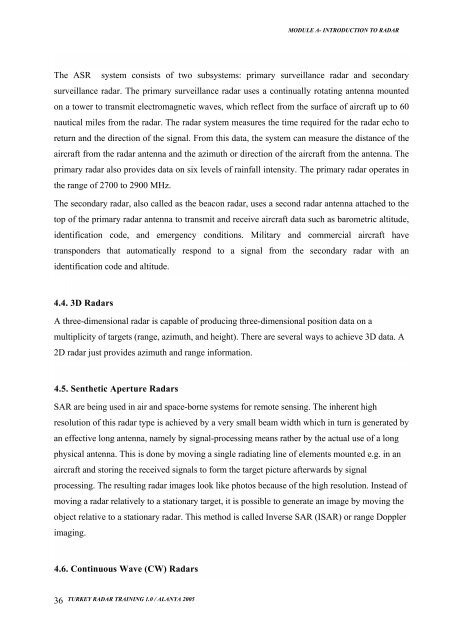training course on weather radar systems - RTC, Regional Training ...
training course on weather radar systems - RTC, Regional Training ...
training course on weather radar systems - RTC, Regional Training ...
- No tags were found...
You also want an ePaper? Increase the reach of your titles
YUMPU automatically turns print PDFs into web optimized ePapers that Google loves.
MODULE A- INTRODUCTION TO RADAR<br />
The ASR system c<strong>on</strong>sists of two sub<strong>systems</strong>: primary surveillance <strong>radar</strong> and sec<strong>on</strong>dary<br />
surveillance <strong>radar</strong>. The primary surveillance <strong>radar</strong> uses a c<strong>on</strong>tinually rotating antenna mounted<br />
<strong>on</strong> a tower to transmit electromagnetic waves, which reflect from the surface of aircraft up to 60<br />
nautical miles from the <strong>radar</strong>. The <strong>radar</strong> system measures the time required for the <strong>radar</strong> echo to<br />
return and the directi<strong>on</strong> of the signal. From this data, the system can measure the distance of the<br />
aircraft from the <strong>radar</strong> antenna and the azimuth or directi<strong>on</strong> of the aircraft from the antenna. The<br />
primary <strong>radar</strong> also provides data <strong>on</strong> six levels of rainfall intensity. The primary <strong>radar</strong> operates in<br />
the range of 2700 to 2900 MHz.<br />
The sec<strong>on</strong>dary <strong>radar</strong>, also called as the beac<strong>on</strong> <strong>radar</strong>, uses a sec<strong>on</strong>d <strong>radar</strong> antenna attached to the<br />
top of the primary <strong>radar</strong> antenna to transmit and receive aircraft data such as barometric altitude,<br />
identificati<strong>on</strong> code, and emergency c<strong>on</strong>diti<strong>on</strong>s. Military and commercial aircraft have<br />
transp<strong>on</strong>ders that automatically resp<strong>on</strong>d to a signal from the sec<strong>on</strong>dary <strong>radar</strong> with an<br />
identificati<strong>on</strong> code and altitude.<br />
4.4. 3D Radars<br />
A three-dimensi<strong>on</strong>al <strong>radar</strong> is capable of producing three-dimensi<strong>on</strong>al positi<strong>on</strong> data <strong>on</strong> a<br />
multiplicity of targets (range, azimuth, and height). There are several ways to achieve 3D data. A<br />
2D <strong>radar</strong> just provides azimuth and range informati<strong>on</strong>.<br />
4.5. Senthetic Aperture Radars<br />
SAR are being used in air and space-borne <strong>systems</strong> for remote sensing. The inherent high<br />
resoluti<strong>on</strong> of this <strong>radar</strong> type is achieved by a very small beam width which in turn is generated by<br />
an effective l<strong>on</strong>g antenna, namely by signal-processing means rather by the actual use of a l<strong>on</strong>g<br />
physical antenna. This is d<strong>on</strong>e by moving a single radiating line of elements mounted e.g. in an<br />
aircraft and storing the received signals to form the target picture afterwards by signal<br />
processing. The resulting <strong>radar</strong> images look like photos because of the high resoluti<strong>on</strong>. Instead of<br />
moving a <strong>radar</strong> relatively to a stati<strong>on</strong>ary target, it is possible to generate an image by moving the<br />
object relative to a stati<strong>on</strong>ary <strong>radar</strong>. This method is called Inverse SAR (ISAR) or range Doppler<br />
imaging.<br />
4.6. C<strong>on</strong>tinuous Wave (CW) Radars<br />
36<br />
TURKEY RADAR TRAINING 1.0 / ALANYA 2005
















